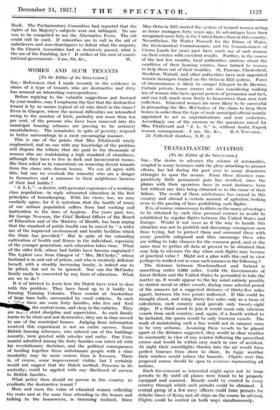TRANSATLANTIC AVIATION [To the Editor of the SPECTATOR.] SIR,—The desire
to advance the science of aeronautics, coupled in many instances with the glory attaching to pioneer efforts, has led during the past year to many disastrous attempts to span the oceans. From these disasters com- paratively little permanent gain has resulted, since the planes with their operators have in most instances been lost without any data being obtained as to the cause of their failure. The result of these misfortunes has caused in this country and abroad a certain amount of agitation, looking
even to the passing of laws prohibiting such flights. • It is, of course, unnecessary to dilate on the many advantages to be obtained by such close personal contact as would be established by regular flights between the United States and Europe. Would it not seem as if the way to handle this situation was not to prohibit and discourage courageous men from trying, but to protect them and surround them with every possible safeguard and thus encourage those who are willing to take chances for the common good, and at the same time to gather all data at present to be obtained that may help to advance the day when such flights may become of practical value ? Might not a plan with this end in view perhaps be worked out in some such manner as the following ?
The distance between Newfoundland and Ireland is
something under 2,000 miles. Could the Governments of Great Britain and the United States be persuaded to take the matter up, -it would appear to the lay mind entirely possible to station naval or other vessels, during some selected period of the summer (at a suggested distance of thirty-five miles apart), between the two points indicated. If this could be brought about, and using thirty-five miles only as a basis of calculation, each country need provide only twenty-eight ships. If a third cared to join it would mean only nineteen vessels from each country, and, again, if a fourth wished to be included, the quota would -be only fourteen vessels. The work of maintaining such a line would not in summer seem to be very arduous. Assuming these vessels to be placed apart at the distance suggested, they would in clear weather be constantly in view of any aviator following the prescribed course and would be within easy reach in case of accident.' At night their searchlights thrown into the air would form perfect beacons froni shore to shore. In foggy weather their wireless would reduce the hazards. Flights over this proposed course should be open to aviators representing all nations.
Each Government so interested might agree not to issue permits to fly until all planes were found to be properly equipped and manned. Boards could be created in every country through which such permits could be obtained. A central group of a few navy officers could issue permits for definite times of flying and all ships on the course be advised. Flights could be carried on both ways simultaneously. Weather conditions would be known every hour for the whole distance across. Very useful data might be collected by licensing certain specified aviators to fly—say at only given heights. For instance, starting four or more planes simultaneously from Ireland—each being required to fly in so far as possible at a set height—the exact wind and weather conditions at a given time could thus be readily ascertained. With sufficient data collected it might be established that when conditions at 3,000 feet were such as to make flying slow or dangerous, by rising to 10,000 feet, or 20,000 feet, perfect conditions would be obtained ; in other words, working out the situation of the air currents vertically as Lieut. Maury worked them out on the oceans in the days of sails. His wind charts, as all mariners know, revolutionized the courses taken by sailing vessels the world over. Such a
scheme should bring about a very large number of flights, as the risk to the individual would be reduced to a minimum.
Perhaps the answer to final success might in part be found by such research. Undoubtedly, a good deal might be learned about aerial compass work as well as wireless communications and other scientific matters.—I am, Sir, &c.,
J. PENNINGTON-GARDINER.
21 Federal Street, Boston, Mass., U.S.A.































 Previous page
Previous page